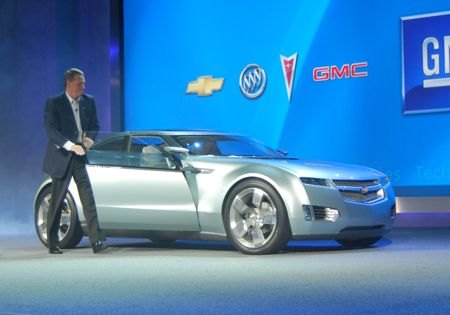Volt Birth Watch 104: GM Apologizes for Change in Volt's Propulsion. Almost.
As we reported previously, the plug-in electric – gas Chevrolet Volt will not, as originally stated, recharge its batteries on the fly. Which raises all kinds of questions about exactly what it DOES do, how it does it, how much it will cost to do it and why they’re doing it the way they’re doing it. While GM didn’t step-up and spill the beans on this mission critical mechanical issue (they were “outed” by Edmunds), an eagle-eyed TTAC reader spotted a post-facto mea culpa at the bottom of a USA Today article on the company’s investment in Flint. “GM initially said the Volt would be able to run 40 miles on its lithium-ion batteries, with a small internal combustion engine recharging the batteries to extend the range hundreds of miles. A top executive said the same thing as recently as last week. But company spokesman Rob Peterson said Wednesday that engineers changed the design so the Volt engine will power a generator that would run the electric motor after the batteries are depleted. A small amount of power from the generator will recharge the batteries, but most will be used to directly run the car, he said. He said bypassing the batteries is more efficient, and GM did not intend to deceive people by maintaining that he motor would only be used to recharge the batteries. ‘At the end of the day, to the consumer, the vehicle will operate much the same way,’ he said.” [thanks to peteinson for the link]
More by Robert Farago


































Comments
Join the conversation
correct me if im wrong and i might be. the epa required the engine to recharge the battery after completing the city cycle even though it was not drained enough to require it. if the gas engine is no longer responsible for charging the battery then the requirment for the charged battery not aply either. meaning that the rating would go from 48 to the hundread mpg because the motor never kicked in and gas was not used.
When the battery of the Volt claims to be empty it has about the same capacity left as an Prius when it is full. So think of an empty Volt as a car running in Prius mode. Geotpf : The Prius doesn't get its efficiency on the highway from its partly battery driven transmission but from its shape. A car with Prius but not its weight due to extra gears and batteries would most likely be more efficient on the route between L.A. and las Vegas.
Power flexibility & reliability - electric drive cruise ships have multiple generators, meaning that one, or even several, can be off line for times when (a) less power, or speed, is required, and/or (b) maintenance is required. A ship with fewer engines (as in 1 or 2 The I’m a Naval Architecture/Marine Engineer wrote this I did not. I took this to mean one diesel could drive multiple generators. I did not correct generators to alternators nor Achitecuture to architect. I just wanted him to understand that one diesel driving multiple generators, the diesel would fail before generators, that probably would need grease for bearing and brushes/points replaced both easy on the fly jobs.
It doesn't matter what they say it will be, because it won't be at all. Look at how low that windshield is; ZZTop couldn't drive this car. What a scam, the taxpayers give Detroit money year after year to meet this or that regulation or to help with battery technology. At the end of the day Detroit says ' We can't do it" Wonder where all that money went. The Japanese can and are doing it, and have been for a long time. What would our air smell like if we didn't have millions of Hondas and Toyotas on the road? Let the Japanese foul their air with factories and build the cars. Send them all the raw materials they need. The 'Volt" is the final insult to the American consumer. If they had spent half as much on development as they have on advertising this (non)thing, we might already have one of their paltry runs of proposed production. Here is one area where they did not lie: their factories will produce zero waste in the future because they will not be producing anything at all.